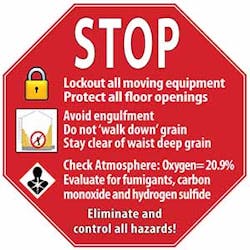It’s been described as being caught in quicksand and it happens just as quickly.
Five seconds. That is how quickly a worker can become engulfed in flowing grain and be unable to get out. Sixty seconds. That is how quickly a worker can be completely submerged in flowing grain. More than half of all grain engulfments result in death by suffocation.
In 2010, at least 26 U.S. workers were killed in grain engulfments, the highest number on record. In the past 50 years, more than 900 cases of grain engulfment have been reported with a fatality rate of 62 percent, according to researchers at Purdue University in Indiana.
Record death and injuries in 2010 led OSHA to reach out to the agricultural and grain handling industries to find ways to prevent deaths and injuries. OSHA also developed a local emphasis program for grain handling facilities focusing on the grain and feed industry's six major hazards. These include engulfment, falls, auger entanglement, "struck by," combustible dust explosions and electrocution hazards.
"OSHA is working hard to change the 'it won't happen to me' mindset," said Nick Walters, OSHA regional administrator for six Midwestern states. "Grain handling injuries and deaths can be prevented if employers follow proper safety procedures."
Suffocation can occur when a worker becomes buried by grain as he walks on moving grain or attempts to clear grain built up on the inside of a bin. Moving grain acts like "quicksand" and can bury a worker in seconds. "Bridged" grain and vertical piles of stored grain also can collapse unexpectedly if a worker stands on or near it. The behavior and weight of the grain make it extremely difficult for a worker to get out of it without assistance.
In Ohio, there have been two recent engulfment deaths on family farms in Milan and in Clark County near Springfield. The most recent death occurred May 28. Neither farm is under OSHA jurisdiction as they employ 10 or less individuals.
OSHA has worked with the Ohio State University to develop a grain safety training session as part of the 2012 OSU/OSHA Safety Day on Grain Safety and plans to do a presentation for the Grain Elevator and Processing Society later this year.
"OSHA is working together with the grain and agricultural industries and the agricultural community to train employers and workers about the unique hazards of the grain and feed industry," said Walters. "Through training, decals, brochures, web sites and other means of information communication, we will continue to work to improve awareness of these hazards and the safety and health of workers on Ohio farms and in grain handling facilities. We are committed to preventing the injuries and deaths that have been too frequent in the industry in recent years."
OSHA, the Grain and Feed Association of Illinois and the Illinois Grain Handling Safety Coalition have also developed a stop sign decal to adhere to grain bin doors using pictures and short phrases reminding entrants to lockout potentially hazardous equipment, stay clear of waist high grain, cover floor holes and to follow other best practices. Individuals or companies can email the Grain and Feed Association of Illinois at [email protected] to request the decal, which is pictured above.
OSHA has also published information related to common grain industry hazards and abatement methods, proper bin entry techniques, sweep auger use and many other grain related topics. OSHA's Grain Bin LEP is used in 25 states.


